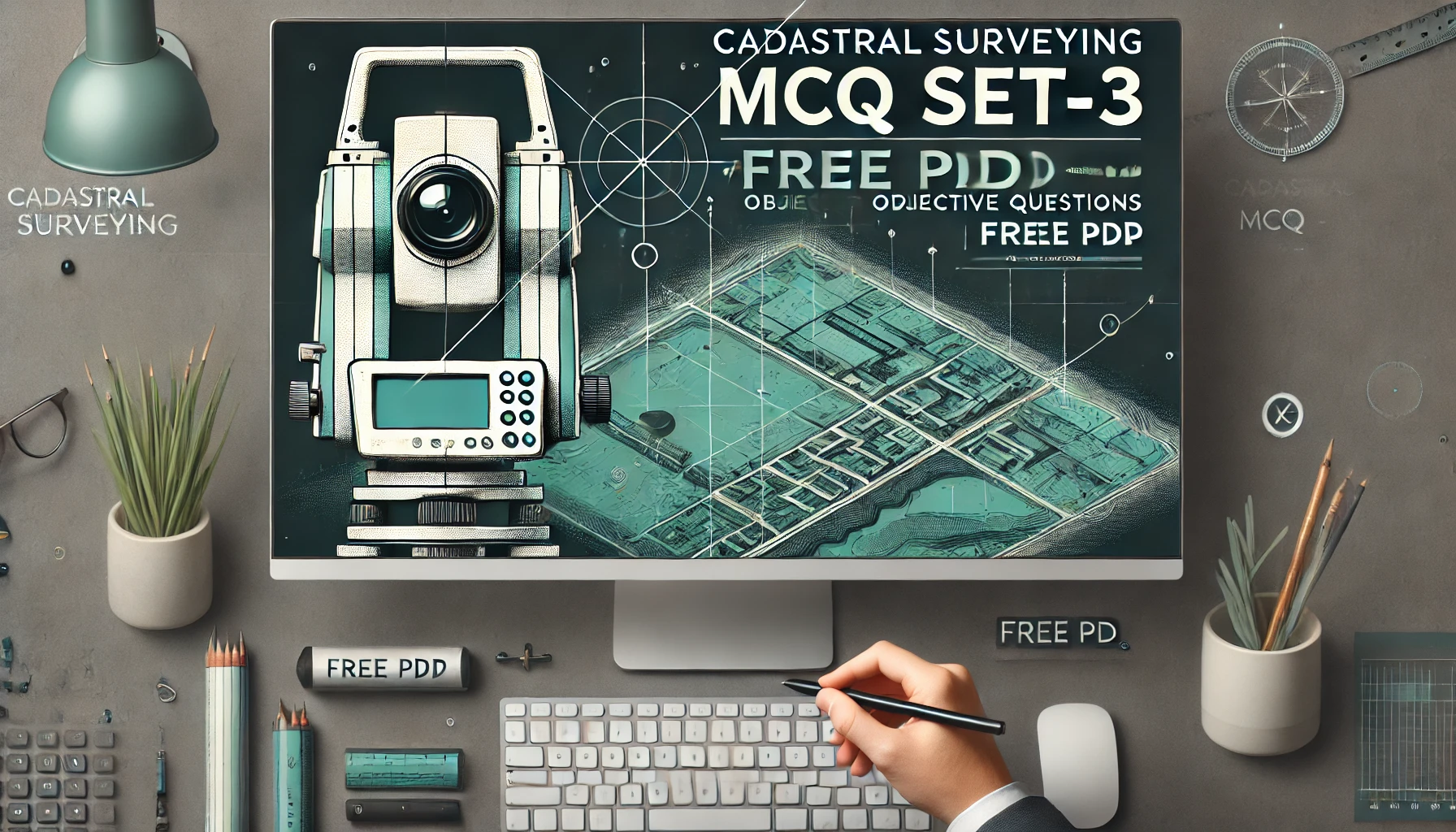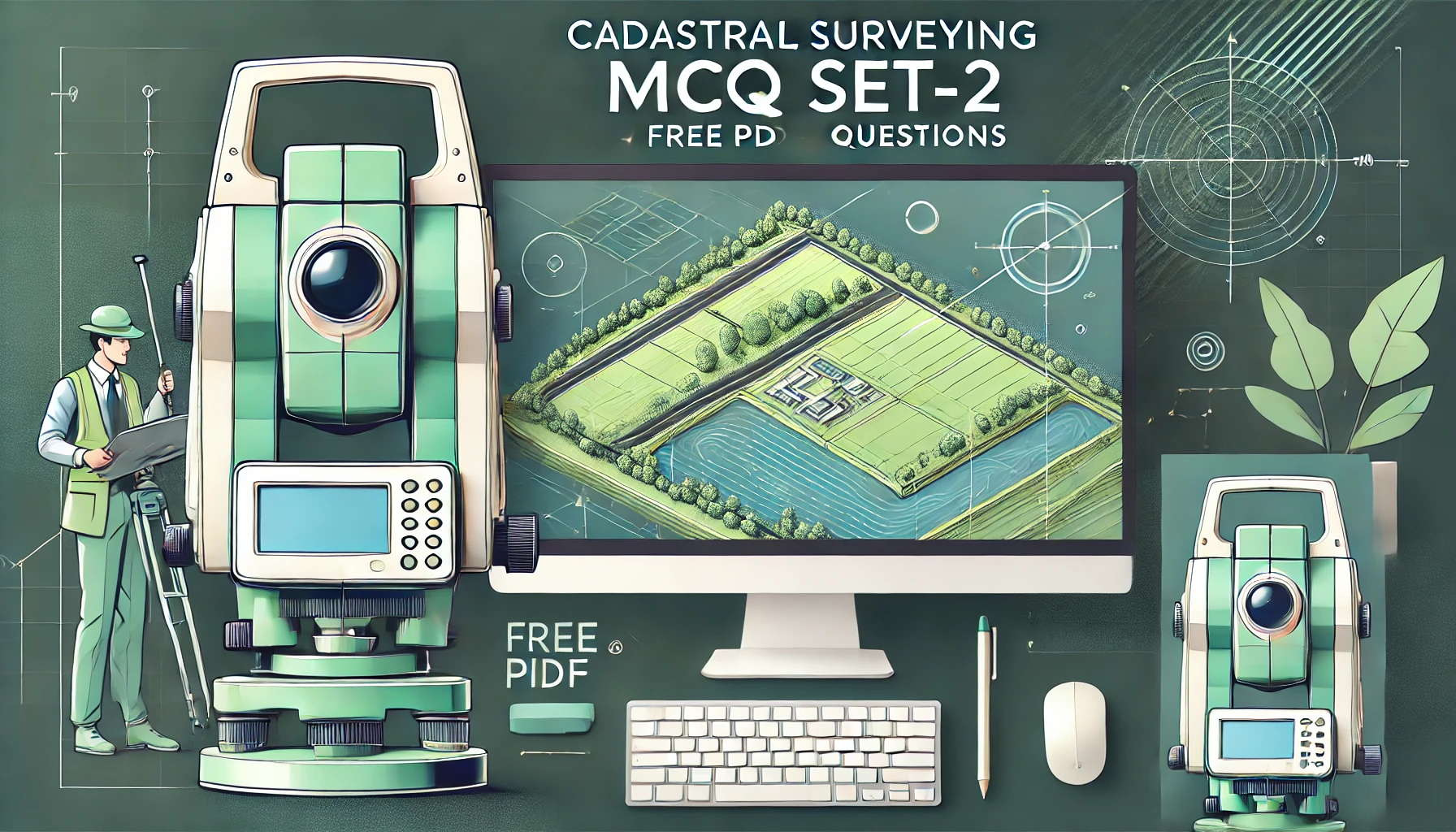Cadastral Surveying MCQ Set-3 [Free PDF] Objective Questions
50+ Cadastral Surveying MCQs Set-3 In this blog, we’ve curated 50+ thought-provoking multiple-choice questions covering the fundamental and advanced concepts of cadastral surveying. ‘Cadastral Surveying MCQ Set-3 [Free PDF] Objective Questions’ is designed to help you refresh your basics, challenge your knowledge, and gain practical insights into property boundaries, land measurement, and survey techniques. Whether you’re a surveying student, GIS professional, or preparing for competitive exams, this quiz is the perfect way to enhance your cadastral surveying expertise. Let’s dive into the ‘Cadastral Surveying MCQ Set-3 [Free PDF] Objective Questions’ and start exploring! 1. What is the first step in establishing a land registration system? A. Developing public awareness B. Conducting cadastral surveys to determine land boundaries C. Establishing legal frameworks for land ownership D. Registering land titles in the public register Answer A. Developing public awareness 2. Which aspect of land policy addresses the need for effective regulation of land development? A. Effective regulation of land development B. Sustainable land use C. Secure land ownership D. Equitable access to land Answer A. Effective regulation of land development 3. What are some common methods through which individuals gain access to land? A. Purchase, leasing, inheritance B. Government allocation through land reform policies C. Bartering goods or services for land access D. Renting land for agricultural use Answer A. Purchase, leasing, inheritance 4. What is one reason why land policy is considered essential for economic growth? A. Land policy provides a framework for land taxation, which generates government revenue B. Land policy ensures equitable access to resources, which is important for social justice C. Secure property rights promote investment D. Land policy regulates land development to prevent environmental degradation Answer C. Secure property rights promote investment 5. What role do informal settlements play in the current land tenure practices in Nepal? A. Informal settlements have no impact on land tenure practices in urban areas B. Informal settlements are automatically granted legal ownership by the government C. Informal settlements seek formalization of ownership D. Informal settlements are completely ignored in land tenure discussions Answer C. Informal settlements seek formalization of ownership 6. What type of land tenure allows individuals exclusive rights to use and control land? A. Leasehold (provides rights but not ownership) B. Customary tenure (includes communal rights) C. Tenancy (involves renting, not ownership) D. Freehold Answer D. Freehold 7. What are the three types of registration systems mentioned? A. Title registration, Negative systems, Positive systems B. Deed registration, Title registration, Sporadic adjudication C. Title registration, Deed registration, Boundary registration D. Deed registration, Improved deed registration system, Title registration Answer D. Deed registration, Improved deed registration system, Title registration 8. What does the term “Kipat” signify in the context of land tenure systems? A. A communal tenure system for specific ethnic groups B. A system of land allocation based on agricultural productivity C. A form of land tenure that allows for private ownership without restrictions D. A type of statutory land ownership available to all citizens Answer A. A communal tenure system for specific ethnic groups 9. What is the difference between formal and informal property rights? A. Formal rights can only be held by individuals, while informal rights can be held by groups. B. Formal rights are legally recognized; informal rights are not. C. Formal rights are recognized by the community, while informal rights are not. D. Formal rights provide more security than informal rights in all cases. Answer B. Formal rights are legally recognized; informal rights are not. 10. What role do local communities play in providing security of tenure? A. Local communities primarily enforce government laws and regulations regarding land ownership B. Local communities have no impact on security of tenure, which is solely determined by formal legal systems C. Local communities are responsible for land administration and formal legal recognition of property rights D. Local communities recognize and enforce property rights Answer D. Local communities recognize and enforce property rights 11. Which type of land tenure refers to state-owned land that individuals operate under tax obligations? A. Raikar land (privately owned with tax obligations) B. Guthi C. Public land (state-owned for specific uses) D. Government land (state-owned for common interest) Answer B. Guthi See Also: Cadastral Surveying MCQ Set-2 [Free PDF] Objective Questions 12. What is the purpose of land reform interventions by national governments? A. To increase land prices for wealthy landowners B. To eliminate all private land ownership C. To restrict access to land for rural communities D. To promote equitable land distribution Answer D. To promote equitable land distribution 13. What is meant by “a bundle of rights” in land tenure systems? A. A single right to sell land B. A collection of various rights C. A type of land lease agreement D. A government regulation on land use Answer B. A collection of various rights 14. What is the significance of cadastral parcels in land administration? A. Cadastral parcels define property interests and support land administration B. Cadastral parcels serve as a method for land acquisition only C. Cadastral parcels are only relevant in developed countries D. Cadastral parcels are used solely for taxation purposes Answer A. Cadastral parcels define property interests and support land administration 15. What is one of the main benefits of a negative registration system? A. It provides comprehensive legal support for transactions B. It guarantees the title and protects against fraud C. It ensures complete accuracy of land records D. It is fast and less costly Answer D. It is fast and less costly 16. What type of rights do informal proofs represent in land tenure systems? A. Community-recognized use rights B. Ownership rights recognized by the state C. Legal rights enforceable through courts D. Rights that are protected by state law Answer A. Community-recognized use rights See Also: 50+ Cadastral Survey MCQ [Free PDF] – Objective Questions 17. What are the phases in the humankind to land relationship according to Ting and Williamson? A. Land as wealth, land as commodity, land as scarce resource, land as a scarce community resource B. Land as a physical commodity, land as a financial asset, land as a community resource, land as a government asset C. Land as a resource, land as a property, land as a market commodity, land as a community asset D. Land as a wealth source, land as a tradable good, land as a limited resource, land as a shared community resource Answer A. Land as wealth, land as commodity, land as scarce resource, land as a scarce community resource 18. … Read more

